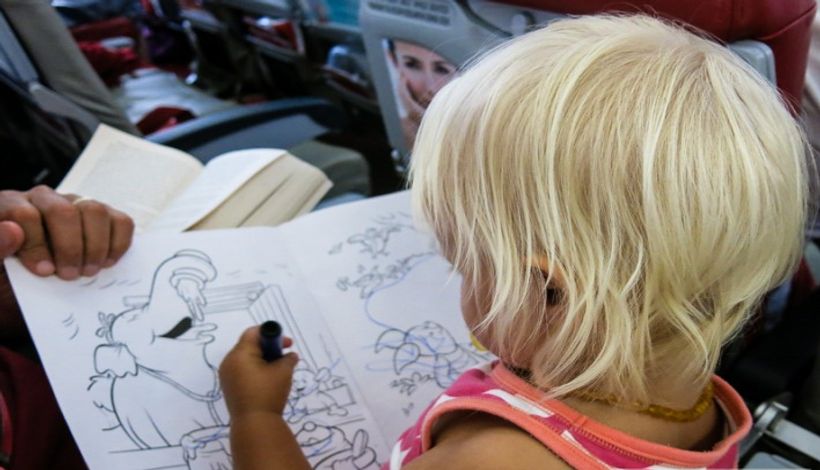10 Screen-Free Tips To Keep Kids Entertained On A Flight!
We all know how energetic kids are in general. But they can seem handful, especially in the small confined space of the airplane cabin.
When you fly with kids, its really important to pack and strategize for the flight accordingly because being unprepared can result in an exhausting experience for you, the child and other passengers.
A tablet or laptop can be an easy way to keep them occupied, but there are several low-tech ways to ensure you and your kids have an enjoyable flight.
Looking to cut down on the screen time of your kids? Here are 10 ways to keep your kids entertained on a flight without ever taking out your tablet.
1.Surprise Them With A New Toy
Before you leave for home, pack your kid’s favourite toys, but keep some room for a surprise toy.
You can pack the surprise toy in their backpack or yours, but don’t reveal it to them until the flight.
Kids are more likely to stay engaged with a new toy for a longer period of time. And though one new toy may be plenty for a flight, on long-haul flights, consider at least two.
2.Pack Crayons & Activity Books

Pack an empty book with crayons and encourage them to become inflight artists when they become restless.
You can also pack a colouring book depending on the age of your kid, however just keep a close eye on them and make sure the plane itself isn’t turning into a piece of art.
You can also set aside some flight time for their learning. Pack an age-appropriate activity book or their school homework.
Just make sure your kids are studying their favourite subject to prevent them from feeling stressed or pressured. Let them choose their subject book before you pack.
3.Download Your Kid’s Favourite Music

It’s a universal fact that kids love music, so use it to your advantage!
Download your kid’s favourite before you leave your home. Get them involved while selecting the songs so that they’re excited about the playlist.
Just remember to pack a pair of headphones.
4.Try Magnet Based Games

Magnetic board games are a great source of entertainment for your kid, especially on flights.
The pieces stick to the playing board, making it more difficult to lose them in-flight. Plus, you’ll also have great fun challenging your little one with classic games like chess, snakes & ladders or Ludo.
Stretch the game time for as long as possible and let them win every now and then so that they don’t lose interest.
You can also purchase magnetic building blocks for your kids to play with on the flight.
5.Read Them A Book

Most passengers won’t mind you reading to your kids.
Bring a few of their favourite books so you can give them options and variety. Comic books are also great since they are relatively lightweight and full of pictures.
After reading a story through once, depending on the age, challenge your kids to practice reading the book back to you.
This should keep you and your kids occupied.
6.Befriend The Cabin Crew

You can extend your kid’s excitement about the flight by bringing a new pal into the picture!
Make friends with the cabin crew and ask them to drop by now and then to say hello and congratulate your child for being so well-behaved.
This is a great way to build your kid’s self-esteem and keep him or her excited about their next trip.
When the seatbelt sign is off, you can take your kid to the back of the airplane so they can talk to the flight attendants when they are not on official duty.
Flight attendants are usually very caring, attentive and enjoy chatting with kids.
7.Play Card Games

Card games are a favourite for many parents flying with kids.
Carry a few of your kid’s favourite card games and, as with every activity on a flight, try to push the game for as long as possible.
Remember that your primary goal is to keep them distracted until you arrive at your destination.
8.Pack Plenty Of Food & Snacks

Snacks can be surprisingly distracting and entertaining for kids during a flight!
Kids tend to become fidgety and unhappy when they are hungry so make sure that you keep their bellies full.
Bring familiar foods that your kids love and enjoy at home, and then pack a special treat that they don’t normally get.
Just avoid pungent foods, as a courtesy to your in-flight neighbours.
9.Have A Conversation With Them

This is the easiest and also the most overlooked way to keep your kids entertained during a flight.
These days parents and children are often so absorbed in their electronic devices that no one takes advantage of a good conversation.
On your next flight, discuss with your kids where you are traveling, what you will see & do. On your way back talk about what they enjoyed about the trip and what they learned from it.
10.Give Your Kid A Camera

It may sound out of the box, but this is something that many parents who fly regularly with their kids like to do.
Now we aren’t saying that give them expensive DSLR cameras, but there are many cameras for kids available out there.
Just make sure that they are seated near the window. They will be occupied taking pictures from the airplane window.
And bring along a large memory card, because once your kids get excited about having a camera and taking pictures, they just may take pictures of every single thing.
In case you forget to pack things like books, headphones or snacks, don’t worry, we’ve got your back! Simply download the AirWhizz app to get all the information about different shops at the airport along with real-time flight updates, airline information and much more.
Have a great journey with your kid and Fly Stress-Free!



























